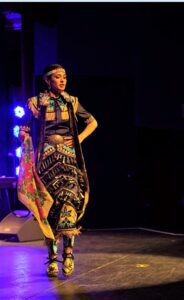‘Why We Dance’ Series: Amber Hein
Everyone dances for a different reason. Some are just learning. Some feel that it’s a connection to their home and culture. Others dance for healing or to celebrate a personal triumph. And some are competitive dancers. Whatever the reason, our hearts lift up as we see them enter through the Eastern Doorway and join the circle. Pow-Wow dances are expressions of self and spirituality, history and culture. There are many different types of dances and many different styles of regalia to go with the dances. Dances tell important stories – both personal and cultural.
The Anishinabek News hopes this series brings you light and hope during these times of uncertainty, and inspiration to keep moving forward on your journey – whatever it may be; or maybe even dance.

By Amber Hein, Algonquins of Pikwàkanagàn First Nation
I was born into this world with mixed ancestry. On my mother’s side, I am Algonquin from the Anishinabek Nation. An original inhabitant of Turtle Island, known today as North America. On my father’s side, I am German. My German ancestors settled to North America sometime in the late 1600s. With that said, you could say that I grew up with one foot in two very different worlds.
There is a lot of stigma between my German and Indigenous ancestors with respect to mainstream Western Culture and Traditional Indigenous Culture. For the most part, I was raised with mainstream values. In an ideal up bringing, I would have had an equal opportunity to both sides of my culture. Unfortunately, a lot of the traditional ways of my Indigenous ancestors were assimilated through colonization and the Residential School systems.
I began dancing at an early age, but stopped when I was 12 years old. Until that age, the opinions of others didn’t affect me much. When you are young, you don’t really think about how people look at you or label you. It wasn’t until my early teens that I really felt the weight of this. To the average individual, you couldn’t tell I was First Nation based on my looks, so I was able to hide that side of me easily. I did this for many years, and by doing so, I became very disconnected with my identity. Sometime in my early 20s, that changed. I began to reconnect with my culture and I would go to my community’s annual pow wow. I watched my relations dance and listened to the songs and the words of my people. It was the drum that really spoke to me though; the heart beat of Mother Earth. I would get this feeling inside of my chest and it would often bring me to tears. I know now that this feeling was my spirit, longing to be reconnected.
Fast forward to April 2019, when I made the decision to dance in the pow wow again. I chose Old Style Jingle, known as the healing dance and that’s exactly what happened— through dance, I began my healing journey.
The decision to dance has changed my life in so many beautiful ways and has presented me with many opportunities to explore my culture and re-establish my connection. I am an artist; I bead, make moccasins and have sewn a ribbon skirt. I have traditional knowledge; I have brain tanned a deer hide and harvested my first moose. I am a language reviver, dedicating time to learn and speak the language of my people. All things that my ancestors did before me. It’s very empowering to learn and understand where you come from. My dance journey has given me a true sense of belonging. I dance to reclaim my Algonquin identity and to connect back to the ways of my ancestors.
Miigwech.


